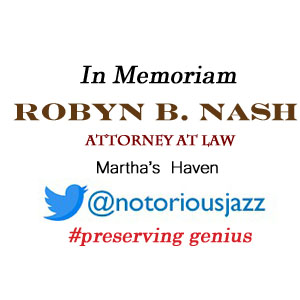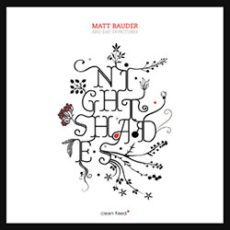
Daily Dose Of Jazz…
Matt Bauder was born and raised in Ann Arbor, Michigan on May 3, 1976 and attended the University of North Texas in Denton, Texas and earned a bachelor of fine arts in jazz and contemporary improvisation at the University of Michigan in Ann Arbor.
From 1999 to 2001 he lived in Chicago, Illinois where he was a part of the city’s modern jazz and improvised music scene. Matt attended graduate school at Wesleyan University in Middletown, Connecticut studying under Anthony Braxton and received a master’s degree in composition. He lived in Berlin, Germany for a year, then moved to New York City in 2005.
In 2003, Bauder released his debut album, Weary Already of the Way, on 482 Music. His sophomore album in 2007 was the first album from his long-form improvisational jazz trio Memorize the Sky, featuring Bauder on saxophone, clarinet, bass clarinet and percussion, Zach Wallace on bass, vibraphone and percussion, and Aaron Siegel on drums and percussion. The band released two more albums in 2008 and 2010.
His next trio, Hearing Things, had the saxophonist leading JP Schlegelmilch on organ and Vinnie Sperrazza on drums. Never limiting himself to one genre, Bauder’s next venture formed the doo-wop jazz group White Blue Yellow & Clouds, covering songs by the Beach Boys, The Flaminogos and The Mystics.
His Brooklyn-based jazz quintet Day in Pictures released two albums on Clean Feed Records, in which heplayed tenor saxophone and composed the songs on both albums. Matt has since performed as part of the Arcade Fire’s touring lineup, played saxophone and clarinet on Will Butler’s debut album Policy, and has played in the Broadway production of Fela!
Ever busy, saxophonist Matt Bauder continues to perform, compose and collaborate on numerous projects across genres.
More Posts: bandleader,clarinet,drums,guitar,history,instrumental,jazz,music,saxophone,vocal
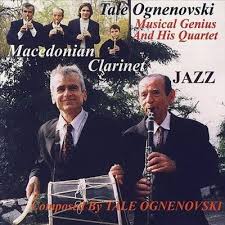
Daily Dose Of Jazz…
Tale Ognenovski was born April 27, 1922 in Brusnik, Bitola, Kingdom of Yugoslavia. He inherited his talent from his reed pipe great-grandfather Ognen and grandfather Risto and his father Jovan who played bagpipes. When he was seven he began playing on the reed pipe. With his father passing away in 1937 and when he was fifteen his grandmother gave him some money to buy his first clarinet.
During WWII he served as a Macedonian Partisan, Tale began playing clarinet at celebrations and concerts in villages and the town of Bitola with numerous musicians. For three years beginning in 1951 he worked as a member of the Police Wind Orchestra and from 1954 till 1956 he worked with the Public Town Skopje Orchestra.
1956 saw him performing to a capacity audienceat Carnegie Hall in New York City as a clarinet and reed pipe/recorder soloist of the Macedonian State Ensemble of Folk Dances and Songs. A seven year residency starting in 1960 had Ognenovski working with Radio Television Skopje. He went on to play in orchestras and ensembles that toured North America, and Europe.
HIs recordings were not singularly jazz, but included the works of Benny Goodman and Artie Shaw. Tale also recorded classical and folk dances, often interlinking the three genres. Alongside his son Stevan, they arranged for two clarinets the music of Mozart. He was the recipient of twenty-one prestigious awards, had several articles and was recognized as one of the top 100 clarinetists of all time.
Clarinetist Tale Ognenovski, who authored a book on Macedonia dance and was biographed by his son Stevan, died in Skopje, Macedonia on June 19, 2012.
More Posts: arranger,bandleader,clarinet,history,instrumental,jazz,music,recorder
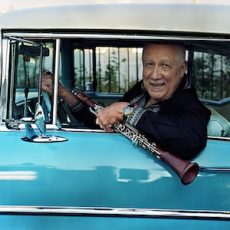
PAQUITO D’RIVERA QUINTET
Paquito D’Rivera is a living monument of Latin jazz. Born in Havana in 1948, he was introduced to music at an early age by his father, who is a classical saxophonist but also with a clear passion for listening to jazz. During his studies at the Havana Conservatory of Music he met Chucho Valdés with whom in 1967 he created the Orquesta Cubana de Música Moderna. But it was in 1973 that the two laid the foundations for their legend: they founded the group Irakere, mixing jazz, rock, classical and Cuban music. A mix with Western music certainly not too pleasing to the Cuban regime: it was precisely the continuous interference of the communist government that pushed D’Rivera to ask for political asylum from the United States in 1980.
Even in his new homeland he soon emerged as a beacon of Latin jazz . He collaborates with McCoy Tyner, George Coleman, Chick Corea, Tito Puente, Astor Piazzolla, while in his formations he welcomes young musicians, projecting them towards international fame (Michel Camilo, Danilo Pérez, Hilton Ruiz, Claudio Roditi). In 1989 he joined one of the most amazing Afro-Latin orchestras that have ever graced the stage, the United Nation Orchestra created by Dizzy Gillespie, of which he himself became director after Gillespie’s death.
He is the only artist who can boast of having won the Grammy Award for both jazz, Latin and classical music. And D’Rivera has won quite a few awards: the last two at the 2023 Latin Grammys for the best Latin jazz/jazz album ( I Missed You Too!, with Chucho Valdés) and for the best contemporary classical composition (the Concerto Venezolano , recorded by trumpeter Pacho Flores..
The Band:
Paquito D’Rivera: clarinet/saxophone | Jose Rivero: piano | Gaston Joya: double bass | Sebastian Laverde: vibraphone | Mauricio Zottarelli: drums
***Website requires translation
More Posts: adventure,clarinet,club,genius,jazz,music,preserving,restaurant,saxophone,travel
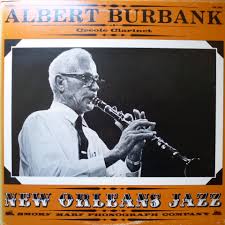
Daily Dose Of Jazz…
Albert Burbank was born March 25, 1902 in New Orleans, Louisiana and was taught clarinet by Lorenzo Tio, one of that city’s most famous clarinet players. Staying in the New Orleans area throughout the 1920s, he played wherever his services were needed. During the 1930s, he worked with Kid Milton’s band but was drafted into the US Navy during World War II.
Upon demobilization, he worked internationally with the bands of Paul Barbarin and Kid Ory. Returning to New Orleans he played with several of the well-known jazz and brass bands in the city. He was regularly seen at Preservation Hall and toured Australia with a band made up of Preservation Hall musicians.
In 1975 Albertsuffered a stroke but continued playing until his death on August 15, 1976. Many of his recordings of broadcast performances with Kid Ory’s band at San Francisco’s Hangover Club, have been issued on the Danish Storyville label, and some with trombonist Bill Matthews appear on Southland.
Burbank would go on to record with Wooden Joe Nicholas, Herb Morand, Kid Clayton, Paul Barbarin, Percy Humphrey, and Jimmy Archey.
Clarinetist Albert Burbank died on August 15, 1976 in his hometown.More Posts: clarinet,history,instrumental,jazz,music

Daily Dose Of Jazz..
Benny de Weille was born on March 6, 1915 in Lübeck, Germany. He studied clarinet under Hans Helmke and was heavily influenced by Benny Goodman, whom he often emulated in his own ensembles.
Benny made recordings with Teddy Stauffer, Hans Rehmstedt, and Willy Berking in the 1930s and 1940s. In 1940 he led his own Bar Trio. Following World War II he worked at Radio Frankfurt and conducted the Nordwestdeutscher Rundfunk Orchestra.
Clarinetist and bandleader Benny de Weille, whose last recordings were in a Dixieland style in 1951, died on December 17, 1977 in Westerland, Germany.
More Posts: bandleader,clarinet,history,instrumental,jazz,music



